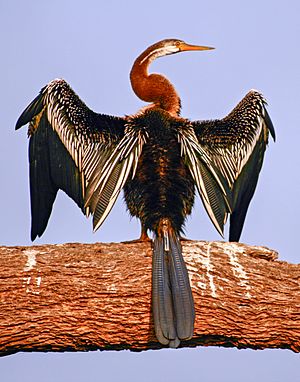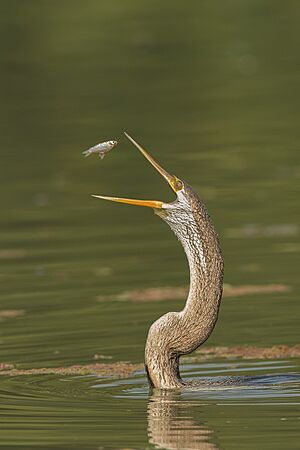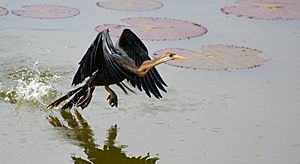Oriental darter facts for kids
Quick facts for kids Oriental darter |
|
|---|---|
 |
|
| Sunning on a perch | |
| Conservation status | |
| Scientific classification | |
| Genus: |
Anhinga
|
| Species: |
melanogaster
|
 |
|
| Distribution map | |
| Synonyms | |
|
Plotus melanogaster |
|
The Oriental darter or Indian darter (Anhinga melanogaster) is a fascinating water bird. You can find it in warm, tropical parts of South Asia and Southeast Asia. This bird has a long, thin neck and a straight, pointy beak.
Like a cormorant, the Oriental darter hunts for fish while most of its body stays underwater. It's really good at spearing fish! After catching a fish, it brings it to the surface, tosses it around, and then swallows it headfirst. Because only its slender neck is seen above the water when it swims, people often call it a snakebird. Just like cormorants, its feathers can get very wet. So, you'll often see it perched on a rock or branch, holding its wings open to dry them in the sun.
Contents
What the Oriental Darter Looks Like
The Oriental darter is a lot like other darter species and cormorants. It has a very long neck, which is its most special feature. This neck has strong muscles and a unique bend. This allows the bird to quickly dart its head forward to stab fish underwater. The edges of its beak have tiny, inward-pointing teeth-like parts. These help it hold onto the fish it spears.
Adult Appearance
Adult darters have black feathers on their upper body. Their wing feathers and inner flight feathers (called tertials) have shiny, silvery stripes. The top of their head and neck are brown, turning black towards the back of the neck. Their belly and chest are dark brownish-black.
A light line runs above their eye and along their throat. Another line goes down the sides of their neck, giving them a striped look. Their eyes are white with a yellow ring around them. This yellow ring becomes brighter when they are ready to breed. The tip of their upper beak is dark, while the base is light brown. The lower beak is yellowish.
Legs and Sex Differences
The legs and webbed feet of young birds and non-breeding adults are yellow. However, breeding birds have darker grey legs and toes with yellow webbing. It's not always easy to tell males and females apart. Males often have small black spots that join together on their white throat.
Female darters usually have a shorter beak. They also tend to have a wide, pale band separating the black on their neck and chest from the back of their neck. This band often ends at the shoulder. Young birds also show this pattern, but their necks are lighter, and they don't have the long, pointy shoulder feathers (scapulars) that adults do.
Flight and Tail
When flying, the Oriental darter is easy to spot. It has a long, thin neck, wide wings, and a wedge-shaped tail. Young birds have a pale brown neck and look whitish underneath. They also lack the white stripe along the side of the neck. The inner flight feathers and central tail feathers look wavy. The tail is long and made of twelve stiff feathers. These feathers often drag on the ground when the bird tries to walk or hop.
Darter Behavior and Life
Oriental darters mostly live in freshwater lakes and streams. They usually hunt alone. They swim slowly with their whole body underwater, using their webbed feet. Only their head and neck move above the water in a jerky way. They quickly dart their neck to spear fish. Then, they bring the fish out of the water, toss it into the air, and swallow it headfirst.
Drying and Flying
You might see them with cormorants. Both birds often spread their wings out to dry when they perch on a rock or tree near the water. Darters sometimes soar high on warm air currents during the hottest part of the day. In normal flight, they flap their wings and then glide.
Nesting and Reproduction
Oriental darters build their nests in groups with other bird species, often in heronries. They make a platform out of sticks on a tree, usually one surrounded by water. Many pairs might nest close together. Before building, the birds flatten the branch. They protect their nest sites from other birds by posturing and thrusting their necks.
The breeding season changes depending on the location. In northern India, it's from June to August (during the rainy season). In southwestern India, it's April to May. In southeastern India, it's during the winter.
Eggs and Chicks
A female darter usually lays three to six eggs. The eggs are spindle-shaped and bluish-green with a white, chalky coating that can get dirty over time. Both parents take turns sitting on the eggs. They start incubating after the first egg is laid, so the chicks hatch at different times.
Newly hatched chicks are bare, with only a little down on their heads. As they grow, they become covered in white down. The chicks get food by putting their heads deep into their parents' throats.
Molting and Sounds
After the breeding season, adult darters lose all their flight feathers at once. This means they can't fly for a short time. If they are disturbed from their perch during this period, they dive into the water and try to escape underwater. Young chicks also use this escape behavior from the nest.
Darters are usually very quiet. However, at the nest, they make grunting and croaking sounds. They also make a two-part sound like chigi-chigi-chigi. Chicks are very noisy when they are begging for food. Adults sleep together in groups in trees near or over water.
Predators and Human Use
Sometimes, large birds of prey like the Pallas's fish eagle (Haliaetus leucoryphus) hunt darter chicks, especially those that are more than half grown. The long shoulder feathers of darters were once popular for decorating hats.
In some parts of northeastern India, local tribal people used darters to catch fish from streams. They would tie a ring around the bird's neck. This stopped the bird from swallowing the fish, just like in cormorant fishing in parts of Southeast Asia.
Images for kids
See also
 In Spanish: Pato aguja asiático para niños
In Spanish: Pato aguja asiático para niños






